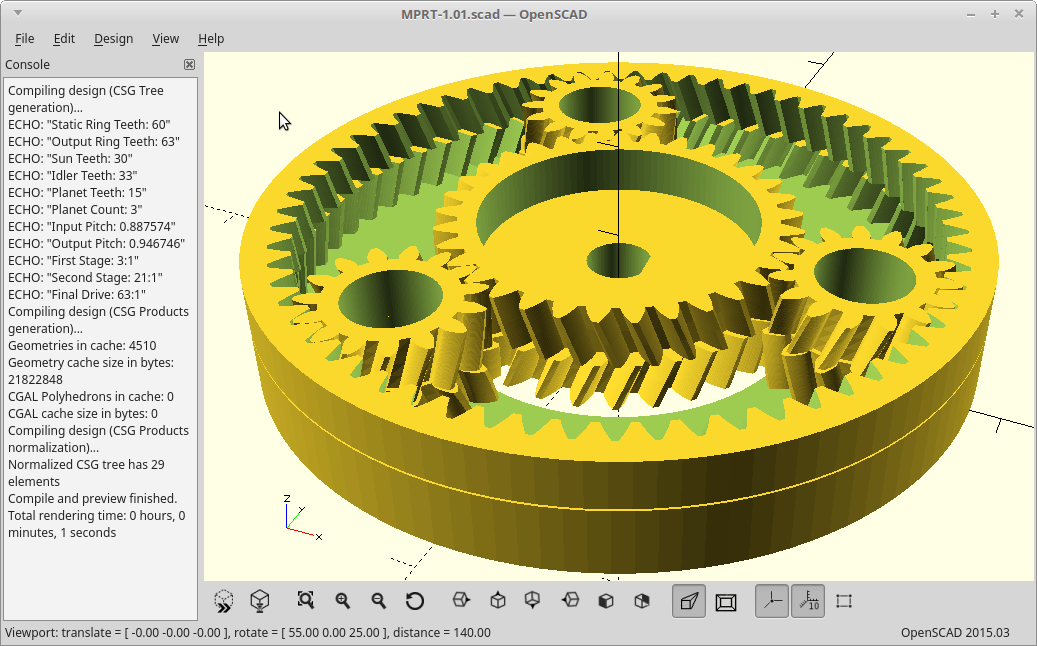Cleaned it up, and uploaded the latest.
Fully parametric, no inherent extra backlash, and now with minimal extra stuff.

The goal now is to have this properly 'included' into other things, and then have you further modify the base transmission parts there instead of trying to make this a 'one stop shop'. That will take some research as I'm more of an abuser of OpenSCAD than a user.
And now, some eye candy.
If you look in the console part of these images, you'll see the numbers used to generate these and the resulting gear ratio.
<EDIT> I forgot to mention.. all that was changed in the source to render these three different transmissions was the ring_teeth, sun_teeth, and planet count. Everything else was parametric and scaled appropriately. </EDIT>



 Daren Schwenke
Daren Schwenke
Discussions
Become a Hackaday.io Member
Create an account to leave a comment. Already have an account? Log In.
Hello Daren, can you provide the files you generated? i'll try to build one in ABS for a robotic system. I'll send you some of my results when it's ready.
Are you sure? yes | no
The OpenSCAD source is up here and on Github, and you can generate any or all of these yourself, changing it by just changing some numbers. That is what 'parametric' modeling means. You can change parameters, and the model adjusts according to those changes. Doing this in OpenSCAD means getting all the math right yourself though. OpenSCAD is quirky, but awesome...
If you need help getting going with OpenSCAD, send me a private message. (Click on my name, and then in the title bar area on the right side, you'll find the button).
The editor in OpenSCAD isn't very good, but you can use your own easily. Just close the editor part, and when you save the file in another editor, OpenSCAD will notice and re-render the preview for you.
Are you sure? yes | no
Hm ...
This makes me wonder if you could drive the whole thing "inside out", i.e. attach the input side sun gear to the robot frame, drive the lower outside gear, and then attach something to the output side sun gear. An added bonus would be that you could then add gear teeth to the outside of the input side outer gear, and add even more reduction!!! >:3
Are you sure? yes | no
You are going to make me think now.. I believe you'll be working against the first stage gear reduction then though, so your reduction would be limited to the second stage essentially. I think you would loose some efficiency as such as well. Further analysis needed...
Are you sure? yes | no
Yeah, when driving the outer gear and keeping the input sun stationary, the second outer gear would spin fairly fast... Probably roughly the input speed with slight reduction. But it wouldn't really be that different from rotating the sun gear and keeping the outer gear stationary, so the friction it experiences would be the same. Added bonus, you could add fins or markings on the outside and build a rudimentary optical encoder with fairly high precision that way :> || Edit, on second thought it would be a bit silly to place an optical encoder on the secondary outer gear because it'll probably have a weird ratio compared to the output speed. A simple encoder on the motor is probably still a better idea >~>
Are you sure? yes | no
Hmm, if I understand correctly, the slant in the teeth not only allows them to mesh more gradually, but will also keep the planet gears centered, due to the forces acting in opposite directions vertically? Does that mean you could make them a bit thinner and thus not touch the top/bottom plates at all?
Are you sure? yes | no
They will be clearanced to not rub already, and that is basically what I'm hoping for. The forces aren't balanced though while the sun is driving them as it introduces another up/down force on the bottom of the planets. Perhaps if I made the top a ratio of the bottom I could balance that as well.
Are you sure? yes | no
Ideally you'd want herringbone on each stage. Otherwise each ring experiences an unbalanced thrust force. But unfortunately I think that would make it physically impossible to assemble :)
I don't think there is any way to balance thrust on the planets in the current version. You can do it with carrier driven, though. And interestingly you need the helix direction to be the same on the input and output stages, because the opposite side of the tooth is in contact on each of them. But the rings still thrust toward or away from eachother based on the motor direction.
Are you sure? yes | no